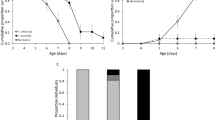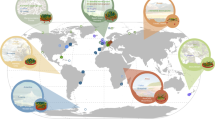Summary
State-dependent changes in prey preference are among the phenomena to be expected in studies of predator behaviour. For example, the rate of attack on each prey type is well known to be affected by the state of satiation, the dynamics of which is often assumed to parallel that of gut fullness. An interesting question is whether satiation alone is the determinant of the attack rate or whether the particular mixture of prey types in the predator's direct environment has an additional influence by itself. To detect examples of the latter type the predictive method proposed by Cock (1978) may be useful. In the present paper the predictive tool is a model built on the assumption that gut fullness is the sole internal state variable determining the attack rate. It is provided with parameter estimates from observations in monocultures of each type and then used to predict predation in mixtures of prey types. When measured predation on these prey types differs from what is predicted, the model may be too simple in various respects, one of which is that predators change prey preference in response to their own sample estimates of the densities of each prey type and their (innate or sample) estimate of the profitability of each prey type in terms of reproductive success. Thus, the lack of fit of the model poses a challenging problem, for to explain it one must identify underlying causes, such as differences in prey quality with respect to scarce nutrients or noxious chemicals that need to be detoxified or rendered harmless in other ways. The predictive approach is illustrated by analysis of preference of predatory mites (Phytoseiulus persimilis Athias-Henriot and Typhlodromus occidentalis Nesbitt) with respect to various stages of development of their prey, the two-spotted spider mite (Tetranychus urticae Koch). The results show that the relation between attack rate and gut fullness might well explain prey stage preference of predatory mites when the prey stages are presented together rather than each alone. In another paper by Dicke et al. (1989) marked deviations between predicted and measured diet are reported when the predatory mite, Typhlodromus pyri Scheuten, was offered a choice between two prey species, i.e. apple rust mites and (larvae of) European red spider mites. The underlying causes are to be revealed by further research, the impetus of which is born out by use of the method proposed by Cock (1978) and extended in this paper.
Similar content being viewed by others
References
Akre BG, Johnson DM (1979) Switching and sigmoid functional response curves by damselfly naiads with alternative prey available. J Anim Ecol 48:703–720
Chesson J (1978) Measuring preference in selective predation. Ecology 59:211–215
Chesson J (1983) The estimation and analysis of preference and its relationship to foraging models. Ecology 64:1297–1304
Cock MJW (1978) The assessment of preference. J Anim Ecol 47:805–816
Colton TF (1987) Extending functional response models to include a second prey type: an experimental test. Ecology 68:900–912
Curio E (1976) The Ethology of Predation. Springer, Berlin Heidelberg New York
Curry GL, DeMichele DW (1977) Stochastic analysis for the description and synthesis of predator-prey systems. Can Ent 109:1167–1174
Dethier VG (1976) The Hungry Fly. Harvard University Press
Dicke M, Sabelis MW,De Jong M (1988) Analysis of prey preference in phytoseiid mites by using an olfactometer, predation models and electrophoresis. Exp Appl Acarol 5:225–241
Dicke M, Sabelis MW, Van Den Berg H (1989) Does prey preference change as a result of prey species being presented together? Analysis of prey selection by the predatory mite Typhlodromus pyri (Acarina: Phytoseiidae). Oecologia 81:302–309
Fernando MHJP, Hassell MP (1980) Predator-prey responses in an acarine system. Res Popul Ecol 22:301–322
Heijmans HJAM (1984) Holling's hungry mantid model of the invertebrate functional response: III. Stable satiation distribution. J Math Biol 21:115–143
Heisey DM (1985) Analyzing selection experiments with log-linear models. Ecology 66:1744–1748
Juliano SA, Williams FM (1987) A comparison of methods for estimating the functional response parameters of the random predator equation. J Anim Ecol 56:641–653
Lawton JH, Beddington JR, Bonser R (1974) Switching in invertebrate predators. In: Usher MB, Williamson MH (eds) Ecological Stability pp 141–158
Lechowicz MJ (1982) The sampling characteristics of electivity indices. Oecologia 52:22–30
Manly BFJ (1974) A model for certain types of selection experiments. Biometrics 30:281–294
Manly BFJ,Miller P Cook LM (1972) Analysis of a selective predation experiment. Am Nat 106:719–736
Metz JAJ, Van Batenburg FHD (1985a) Holling's hungry mantid model for the invertebrate functional response: I. The full model and some of its limits. J Math Biol 22:209–238
Metz JAJ, Van Batenburg FHD (1985b) Holling's hungry mantid model for the invertebrate functional response: II. Negligible handling time.J Math Biol 22:239–257
Metz JAJ, Diekmann O (1986) The Dynamics of Physiologically Structured Populations. Lecture Notes in Biomathematics 68, Springer, Berlin Heidelberg New York pp 511
Metz JAJ, Sabelis MW, Kuchlein JH (1988) Sources of variation in predation rates at high prey densities: an analytic model and a mite example. Exp Appl Acarol 5:187–205
Rabbinge R (1976) Biological Control of the Fruit Tree Red Spider Mite. Simulation Monographs, Pudoc, Wageningen, pp 228
Rogers DJ (1972) Random search and insect population models. J Anim Ecol 41:369–383
Royama T (1971) A comparative study of models for predation and parasitism. Res Pop Ecol, [Suppl] 1:1–91
Sabelis MW (1981) Biological Control of Two-spotted Spider Mites using Phytoseiid Predators. Agricultural Research Reports 910, Pudoc Wageningen,pp 242
Sabelis MW (1985) Predation on spider mites. In: Helle W, Sabelis MW (eds) Spider Mites: Their Biology, Natural Enemies and Control vol. 1B, Elsevier, Amsterdam, pp 103–129
Sabelis MW (1986) The functional response of predatory mites to the density of two-spotted spider mites. In: Dynamics of Physiologically Structured Populations Metz JAJ, Diekmann O (eds) Lecture Notes in Biomathematics 68, Springer, Berlin Heidelberg New York pp 298–321
Sandness JN, McMurtry JA (1972) Prey consumption behaviour of Amblyseius largoensis in relation to hunger. Can Ent 104:461–470
Scott MA, Murdoch WW (1983) Selective predation by the backswimmer Notonecta. Limnol Oceanogr 28:352–366
Skellam JG (1958) The mathematical foundations underlying line transects in animal ecology. Biometrics 14:385–400
Taylor JG (1976) Value of clumping to prey and the evolutionary response of ambush predators. Am Nat 110:13–29
De Wit CT (1960) On Competition. Agricultural Research Reports 66.8, Pudoc, Wageningen pp 82
De Wit CT, Goudriaan J (1978) Simulation of Ecological Processes. Simulation Monographs, Pudoc, Wageningen, pp 175
Author information
Authors and Affiliations
Rights and permissions
About this article
Cite this article
Sabelis, M.W. How to analyse prey preference when prey density varies? A new method to discriminate between effects of gut fullness and prey type composition. Oecologia 82, 289–298 (1990). https://doi.org/10.1007/BF00317473
Received:
Accepted:
Issue Date:
DOI: https://doi.org/10.1007/BF00317473




